Highly Efficient MOF Catalyst Systems for CO2 Conversion to Bis-Cyclic Carbonates as Building Blocks for NIPHUs (Non-Isocyanate Polyhydroxyurethanes) Synthesis
Abstract
1. Introduction
2. Results and Discussion
2.1. Characterization of Catalysts
2.2. Reaction
3. Materials and Experimental Section
3.1. Materials
3.2. Catalysts Characterization
3.3. Product Characterization
3.4. General Procedure for the Carbonation of Bis-Epoxide
3.5. Syntesis of Butadiene Dicarbonate (BDC)
4. Conclusions
Author Contributions
Funding
Conflicts of Interest
Abbreviations
| BDC | [4,4′-bi(1,3-dioxolane)]-2,2′-dione |
| BET | Brunauer–Emmett–Teller |
| CC | Cyclic-carbonate |
| CTAB | cetyltrimethyl-ammonium bromide |
| DFT | Density Function Theory |
| DMSO-d6 | dimethyl sulfoxide |
| FTIR | Fourier transform infrared |
| GC-MS | gas chromatography mass spectrometry |
| HMDA | hexamethylendiamine |
| MOF | metal–organic framework |
| NIPHU | non-isocyanate polyhidroxyurethane |
| NMR | nuclear magnetic resonance |
| PHU | polyhydroxyurethane |
| PU | polyurethane |
| SEM | scanning electron microscopy |
| TGA | thermogravimetric analysis |
| TLC | thin layer chromatography |
| TON | turn over number |
| TOF | turn over frequency |
| XRD | X-ray diffraction |
| 5CC | five-membered cyclic carbonates |
References
- Ghasemlou, M.; Daver, F.; Ivanova, E.P.; Adhikari, B. Bio-based routes to synthesize cyclic carbonates and polyamines precursors of non-isocyanate polyurethanes: A review. Eur. Polym. J. 2019, 118, 668–684. [Google Scholar] [CrossRef]
- Besse, V.; Camara, F.; Méchin, F.; Fleury, E.; Caillol, S.; Pascault, J.-P.; Boutevin, B. How to explain low molar masses in PolyHydroxyUrethanes (PHUs). Eur. Polym. J. 2015, 71, 1–11. [Google Scholar] [CrossRef]
- Benyahya, S.; Habas, J.-P.; Auvergne, R.; Lapinte, V.; Caillol, S. Structure-property relationships in polyhydroxyurethanes produced from terephthaloyl dicyclocarbonate with various polyamines. Polym. Int. 2012, 61, 1666–1674. [Google Scholar] [CrossRef]
- Carrasco Sanchez, C. Análisis Tecnoeconómico de Alternativas para la Producción de di-Isocianato de Difenilmetano DMI sin Producción Intermedia de Fosgeno; Universidad de Sevilla: Seville, Spain, 2019. [Google Scholar]
- Samanta, S.; Selvakumar, S.; Bahr, J.; Wickramaratne, D.S.; Sibi, M.; Chisholm, B.J. Synthesis and Characterization of Polyurethane Networks Derived from Soybean-Oil-Based Cyclic Carbonates and Bioderivable Diamines. ACS Sustain. Chem. Eng. 2016, 4, 6551–6561. [Google Scholar] [CrossRef]
- Dieterich, D. Polyurethane—Nach 50 Jahren immer noch jung. Chem. Unserer Zeit 1990, 24, 135–142. [Google Scholar] [CrossRef]
- Unverferth, M.; Kreye, O.; Prohammer, A.; Meier, M.A.R. Renewable Non-Isocyanate Based Thermoplastic Polyurethanes via Polycondensation of Dimethyl Carbamate Monomers with Diols. Macromol. Rapid Commun. 2013, 34, 1569–1574. [Google Scholar] [CrossRef] [PubMed]
- Schmidt, S.; Gatti, F.J.; Luitz, M.; Ritter, B.S.; Bruchmann, B.; Mülhaupt, R. Erythritol Dicarbonate as Intermediate for Solvent- and Isocyanate-Free Tailoring of Bio-Based Polyhydroxyurethane Thermoplastics and Thermoplastic Elastomers. Macromolecules 2017, 50, 2296–2303. [Google Scholar] [CrossRef]
- Kathalewar, M.S.; Joshi, P.B.; Sabnis, A.S.; Malshe, V.C. Non-isocyanate polyurethanes: From chemistry to applications. RSC Adv. 2013, 3, 4110–4129. [Google Scholar] [CrossRef]
- Kreye, O.; Mutlu, H.; Meier, M.A.R. Sustainable routes to polyurethane precursors. Green Chem. 2013, 15, 1431–1455. [Google Scholar] [CrossRef]
- Pradhan, S.; Pandey, P.; Mohanty, S.; Nayak, S.K. Insight on the chemistry of epoxy and its curing for coating applications: A detailed investigation and future perspectives. Polym. Plast. Technol. Eng. 2016, 55, 862–877. [Google Scholar] [CrossRef]
- Sahoo, S.; Mohanty, S.; Nayak, S.K. Biobased polyurethane adhesive over petroleum based adhesive: Use of renewable resource. J. Macromol. Sci. A 2018, 55, 36–48. [Google Scholar] [CrossRef]
- Schimpf, V.; Max, J.B.; Stolz, B.; Heck, B.; Mülhaupt, R. Semicrystalline Non-Isocyanate Polyhydroxyurethanes as Thermoplastics and Thermoplastic Elastomers and Their Use in 3D Printing by Fused Filament Fabrication. Macromolecules 2019, 52, 320–331. [Google Scholar] [CrossRef]
- Aoyagi, N.; Furusho, Y.; Endo, T. Convenient synthesis of cyclic carbonates from CO2 and epoxides by simple secondary and primary ammonium iodides as metal-free catalysts under mild conditions and its application to synthesis of polymer bearing cyclic carbonate moiety. J. Polym. Sci. Part A Polym. Chem. 2013, 51, 1230–1242. [Google Scholar] [CrossRef]
- Comerford, J.W.; Ingram, I.D.V.; North, M.; Wu, X. Sustainable metal-based catalysts for the synthesis of cyclic carbonates containing five-membered rings. Green Chem. 2015, 17, 1966–1987. [Google Scholar] [CrossRef]
- Bai, D.; Wang, Q.; Song, Y.; Li, B.; Jing, H. Synthesis of cyclic carbonate from epoxide and CO2 catalyzed by magnetic nanoparticle-supported porphyrin. Catal. Commun. 2011, 12, 684–688. [Google Scholar] [CrossRef]
- Rokicki, G.; Parzuchowski, P.G.; Mazurek, M. Non-isocyanate polyurethanes: Synthesis, properties, and applications. Polym. Adv. Technol. 2015, 26, 707–761. [Google Scholar] [CrossRef]
- Lambeth, R.H.; Henderson, T.J. Organocatalytic synthesis of (poly)hydroxyurethanes from cyclic carbonates and amines. Polymer 2013, 54, 5568–5573. [Google Scholar] [CrossRef]
- Ochiai, B.; Inoue, S.; Endo, T. One-pot non-isocyanate synthesis of polyurethanes from bisepoxide, carbon dioxide, and diamine. J. Polym. Sci. Part A Polym. Chem. 2005, 43, 6613–6618. [Google Scholar] [CrossRef]
- Ubaghs, L.; Fricke, N.; Keul, H.; Höcker, H. Polyurethanes with Pendant Hydroxyl Groups: Synthesis and Characterization. Macromol. Rapid Commun. 2004, 25, 517–521. [Google Scholar] [CrossRef]
- Sardon, H.; Pascual, A.; Mecerreyes, D.; Taton, D.; Cramail, H.; Hedrick, J.L. Synthesis of polyurethanes using organocatalysis: A perspective. Macromolecules 2015, 48, 3153–3165. [Google Scholar] [CrossRef]
- Lu, Q.W.; Hoye, T.R.; Macosko, C.W. Reactivity of common functional groups with urethanes: Models for reactive compatibilization of thermoplastic polyurethane blends. J. Polym. Sci. Part A Polym. Chem. 2002, 40, 2310–2328. [Google Scholar] [CrossRef]
- Delebecq, E.; Pascault, J.P.; Boutevin, B.; Ganachaud, F. On the versatility of urethane/urea bonds: Reversibility, blocked isocyanate, and non-isocyanate polyurethane. Chem. Rev. 2013, 113, 80–118. [Google Scholar] [CrossRef]
- Whelan, J.M.; Hill, M.; Sam, W.P. Multiple cyclic carbonate polymers from erythretol dicarbonate. U.S. Patent 2,935,494, 3 May 1960. [Google Scholar]
- Sopeña, S.; Martin, E.; Escudero-Adán, E.C.; Kleij, A.W. Pushing the Limits with Squaramide-Based Organocatalysts in Cyclic Carbonate Synthesis. ACS Catal. 2017, 7, 3532–3539. [Google Scholar] [CrossRef]
- Laserna, V.; Fiorani, G.; Whiteoak, C.J.; Martin, E.; Escudero-Adán, E.; Kleij, A.W. Carbon dioxide as a protecting group: Highly efficient and selective catalytic access to cyclic cis-diol scaffolds. Angew. Chem. Int. Ed. 2016, 53, 10416–10419. [Google Scholar] [CrossRef]
- Fiorani, G.; Stuck, M.; Martín, C.; Belmonte, M.M.; Martin, E.; Escudero-Adán, E.C.; Kleij, A.W. Catalytic Coupling of Carbon Dioxide with Terpene Scaffolds: Access to Challenging Bio-Based Organic Carbonates. ChemSusChem 2016, 9, 1304–1311. [Google Scholar] [CrossRef]
- Darensbourg, D.J.; Moncada, A.I. Tuning the selectivity of the oxetane and CO2 coupling process catalyzed by (salen) CrCl/n-Bu4NX: Cyclic carbonate formation vs aliphatic polycarbonate production. Macromolecules 2010, 43, 5996–6003. [Google Scholar] [CrossRef]
- Pander, M.; Janeta, M.; Bury, W. Quest for an Efficient 2-in-1 MOF-Based Catalytic System for Cycloaddition of CO2 to Epoxides under Mild Conditions. ACS Appl. Mater. Interfaces 2021, 13, 8344–8352. [Google Scholar] [CrossRef]
- Huh, S. Direct Catalytic Conversion of CO2 to Cyclic Organic Carbonates under Mild Reaction Conditions by Metal—Organic Frameworks. Catalysts 2019, 9, 34. [Google Scholar] [CrossRef]
- Liang, J.; Huang, Y.-B.; Cao, R. Metal–organic frameworks and porous organic polymers for sustainable fixation of carbon dioxide into cyclic carbonates. Coord. Chem. Rev. 2019, 378, 32–65. [Google Scholar] [CrossRef]
- Xie, Y.; Wang, T.-T.; Liu, X.-H.; Zou, K.; Deng, W.-Q. Capture and conversion of CO2 at ambient conditions by a conjugated microporous polymer. Nat. Commun. 2013, 4, 1–7. [Google Scholar] [CrossRef]
- Zhang, Y.; Hong, X.; Cao, X.-M.; Huang, X.-Q.; Hu, B.; Ding, S.-Y.; Lin, H. Functional Porous Organic Polymers with Conjugated Triaryl Triazine as the Core for Superfast Adsorption Removal of Organic Dyes. ACS Appl. Mater. Interfaces 2021, 13, 6359–6366. [Google Scholar] [CrossRef] [PubMed]
- Lin, S.; Diercks, C.S.; Zhang, Y.B.; Kornienko, N.; Nichols, E.M.; Zhao, Y.; Paris, A.R.; Kim, D.; Yang, P.; Yaghi, O.M.; et al. Covalent organic frameworks comprising cobalt porphyrins for catalytic CO2 reduction in water. Science 2015, 349, 1208–1213. [Google Scholar] [CrossRef] [PubMed]
- Han, Y.-H.; Zhou, Z.-Y.; Tian, C.-B.; Du, S.-W. A dual-walled cage MOF as an efficient heterogeneous catalyst for the conversion of CO2 under mild and co-catalyst free conditions. Green Chem. 2016, 18, 4086–4091. [Google Scholar] [CrossRef]
- Li, P.-Z.; Wang, X.-J.; Liu, J.; Lim, J.S.; Zou, R.; Zhao, Y. A Triazole-Containing Metal–Organic Framework as a Highly Effective and Substrate Size-Dependent Catalyst for CO2 Conversion. J. Am. Chem. Soc. 2016, 138, 2142–2145. [Google Scholar] [CrossRef]
- Liu, X.-H.; Ma, J.-G.; Niu, Z.; Yang, G.-M.; Cheng, P. An Efficient Nanoscale Heterogeneous Catalyst for the Capture and Conversion of Carbon Dioxide at Ambient Pressure. Angew. Chem. Int. Ed. 2015, 54, 988–991. [Google Scholar] [CrossRef]
- Omae, I. Recent developments in carbon dioxide utilization for the production of organic chemicals. Coord. Chem. Rev. 2012, 256, 1384–1405. [Google Scholar] [CrossRef]
- Liang, J.; Xie, Y.Q.; Wu, Q.; Wang, X.Y.; Liu, T.T.; Li, H.F.; Huang, Y.B.; Cao, R. Zinc porphyrin/imidazolium integrated multivariate zirconium metal–organic frameworks for transformation of CO2 into cyclic carbonates. Inorg. Chem. 2018, 57, 2584–2593. [Google Scholar] [CrossRef]
- Zhang, S.; Zhang, H.; Cao, F.; Ma, Y.; Qu, Y. Catalytic Behavior of Graphene Oxides for Converting CO2 into Cyclic Carbonates at One Atmospheric Pressure. ACS Sustain. Chem. Eng. 2018, 6, 4204–4211. [Google Scholar] [CrossRef]
- Machorro López, J.J. Desarrollo de Catalizadores Heterogéneos Base TiO2 Para la Reacción de Transesterificación de Triglicéridos en la Obtención de Biodiesel; CIDETEQ: Santiago de Querétaro, Mexico, 2015. [Google Scholar]
- Gutiérrez, I.F. Aplicación de Materiales Nanoestructurados Metal-Orgánicos (MOFs) en Procesos de Adsorción y Catálisis Heterogénea; Universidad de Oviedo: Asturias, Spain, 2015; p. 286. [Google Scholar]
- Pettinari, C.; Marchetti, F.; Mosca, N.; Tosi, G.; Drozdov, A. Application of metal—Organic frameworks. Polym. Int. 2017, 66, 731–744. [Google Scholar] [CrossRef]
- Martín, C.; Fiorani, G.; Kleij, A.W. Recent Advances in the Catalytic Preparation of Cyclic Organic Carbonates. ACS Catal. 2015, 5, 1353–1370. [Google Scholar] [CrossRef]
- Fiorani, G.; Guo, W.; Kleij, A.W. Sustainable conversion of carbon dioxide: The advent of organocatalysis. Green Chem. 2015, 17, 1375–1389. [Google Scholar] [CrossRef]
- Darensbourg, D.J.; Yeung, A.D. A concise review of computational studies of the carbon dioxide-epoxide copolymerization reactions. Polym. Chem. 2014, 5, 3949–3962. [Google Scholar] [CrossRef]
- Liu, Q.; Ding, Y.; Liao, Q.; Zhu, X.; Wang, H.; Yang, J. Fast synthesis of Al fumarate metal-organic framework as a novel tetraethylenepentamine support for efficient CO2 capture. Colloids Surf. A Physicochem. Eng. Asp. 2019, 579, 123645. [Google Scholar] [CrossRef]
- Xie, S.; Qin, Q.; Liu, H.; Jin, L.; Wei, X.; Liu, J.; Liu, X.; Yao, Y.; Dong, L.; Li, B. MOF-74-M (M = Mn, Co, Ni, Zn, MnCo, MnNi, and MnZn) for Low-Temperature NH3-SCR and In Situ DRIFTS Study Reaction Mechanism. ACS Appl. Mater. Interfaces 2020, 12, 48476–48485. [Google Scholar] [CrossRef]
- Alvarez, E.; Guillou, N.; Martineau, C.; Bueken, B.; Van de Voorde, B.; Le Guillouzer, C.; Fabry, P.; Nouar, F.; Taulelle, F.; de Vos, D.; et al. The Structure of the Aluminum Fumarate Metal–Organic Framework A520. Angew. Chem. 2015, 127, 3735–3739. [Google Scholar] [CrossRef]
- Si, Y.; Wang, W.; El-Sayed, M.; Yuan, D. Use of breakthrough experiment to evaluate the performance of hydrogen isotope separation for metal-organic frameworks M-MOF-74 (M=Co, Ni, Mg, Zn). Sci. China Chem. 2020, 63, 881–889. [Google Scholar] [CrossRef]
- Wu, X.; Bao, Z.; Yuan, B.; Wang, J.; Sun, Y.; Luo, H.; Deng, S. Microwave synthesis and characterization of MOF-74 (M=Ni, Mg) for gas separation. Microporous Mesoporous Mater. 2013, 180, 114–122. [Google Scholar] [CrossRef]
- Wei, R.-J.; Zhang, X.-H.; Du, B.-Y.; Fan, Z.-Q.; Qi, G.-R. Synthesis of bis(cyclic carbonate) and propylene carbonate via a one-pot coupling reaction of CO2, bisepoxide and propylene oxide. RSC Adv. 2013, 3, 17307–17313. [Google Scholar] [CrossRef]
- García Aguilar, J. Procesos más Eficientes en Catálisis Mediante la Síntesis de Nuevos Recubrimientos y Rellenos; Universidad de Alicante: Alicante, Spain, 2017. [Google Scholar]
- Beyzavi, M.H.; Stephenson, C.J.; Liu, Y.; Karagiaridi, O.; Hupp, J.T.; Farha, O.K. Metal—Organic framework-based catalysts: Chemical fixation of CO2 with epoxides leading to cyclic organic carbonates. Front. Energy Res. 2015, 2, 63. [Google Scholar] [CrossRef]
- Mirabaud, A.; Mulatier, J.-C.; Martinez, A.; Dutasta, J.-P.; Dufaud, V. Investigating Host–Guest Complexes in the Catalytic Synthesis of Cyclic Carbonates from Styrene Oxide and CO2. ACS Catal. 2015, 5, 6748–6752. [Google Scholar] [CrossRef]
- Liu, Q.; Wu, L.; Jackstell, R.; Beller, M. Using carbon dioxide as a building block in organic synthesis. Nat. Commun. 2015, 6, 5933. [Google Scholar] [CrossRef]
- Brunauer, S.; Emmett, P.H.; Teller, E. Adsorption of Gases in Multimolecular Layers. J. Am. Chem. Soc. 1938, 60, 309–319. [Google Scholar] [CrossRef]
- Jagiello, J.; Thommes, M. Comparison of DFT characterization methods based on N2, Ar, CO2, and H2 adsorption applied to carbons with various pore size distributions. Carbon 2004, 42, 1227–1232. [Google Scholar] [CrossRef]
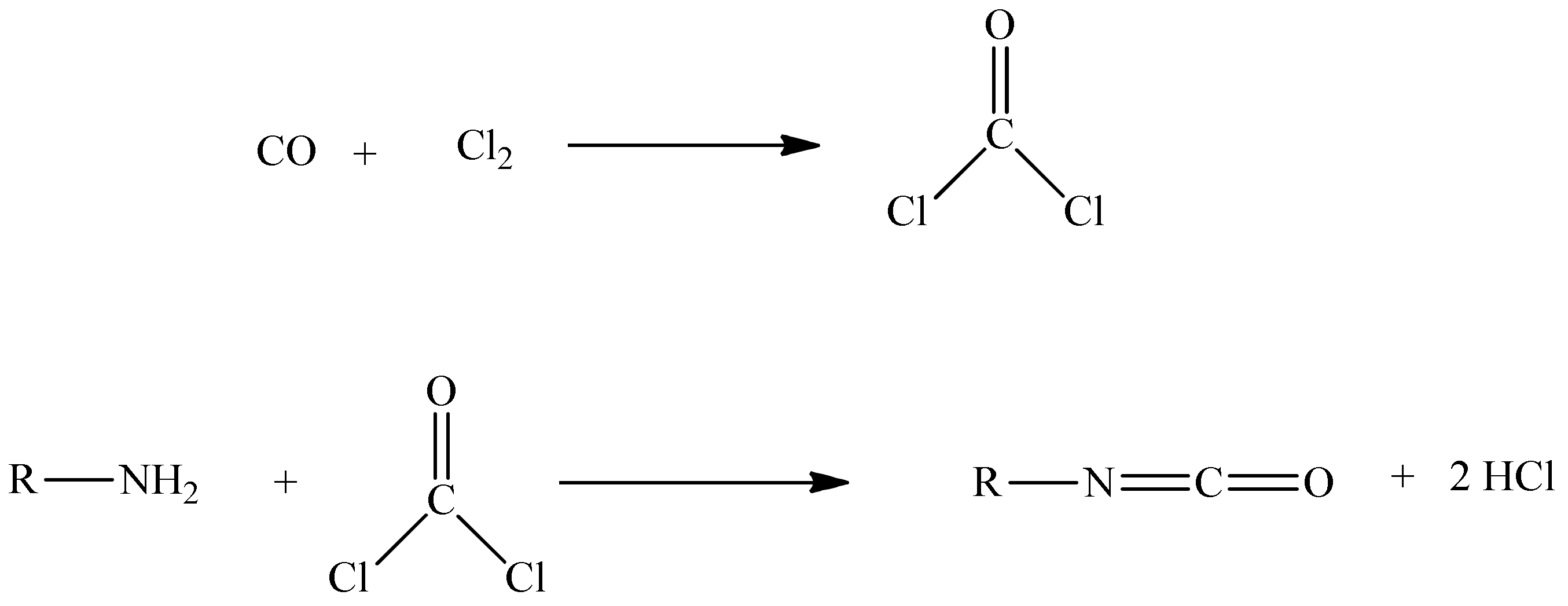

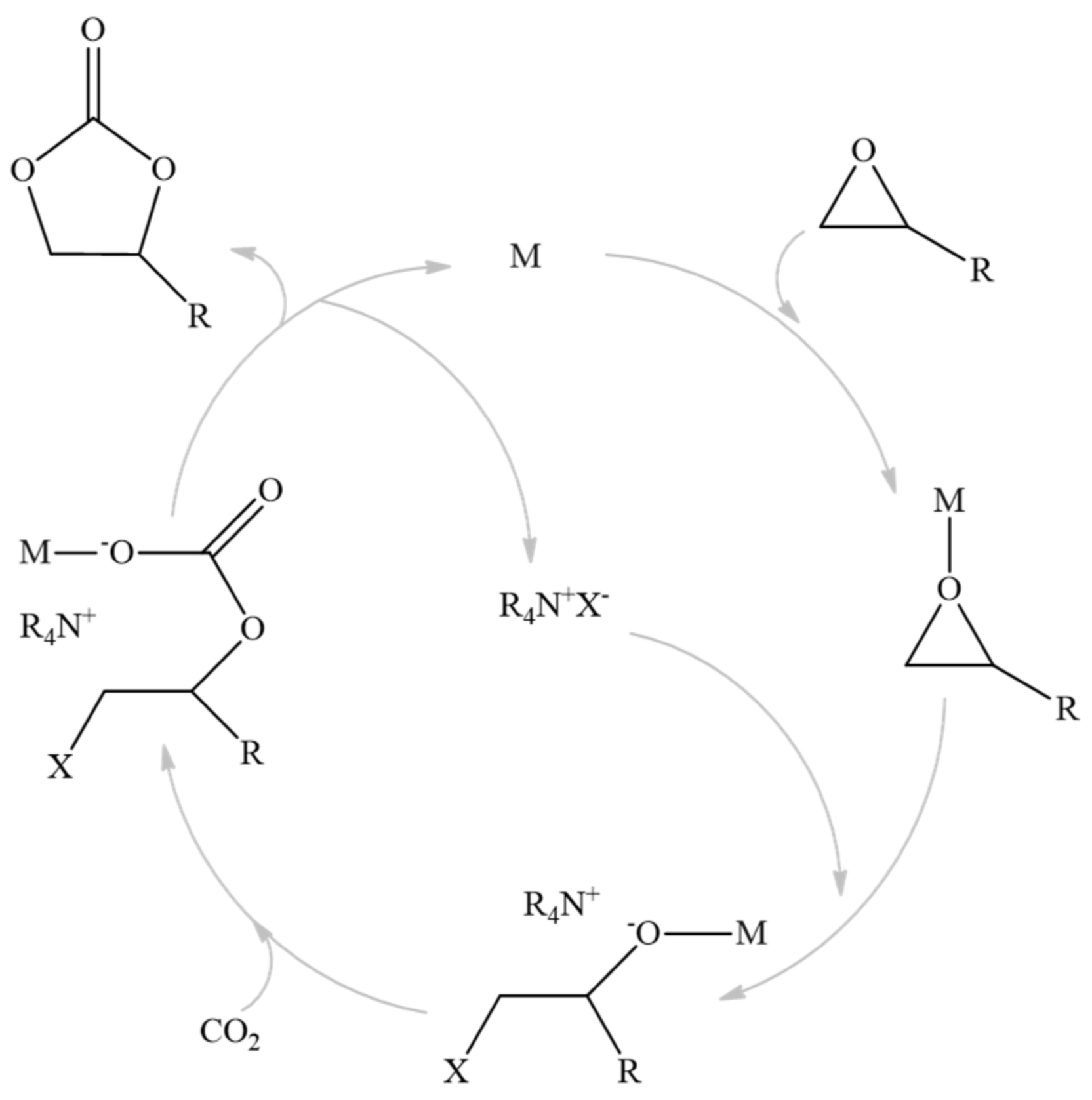
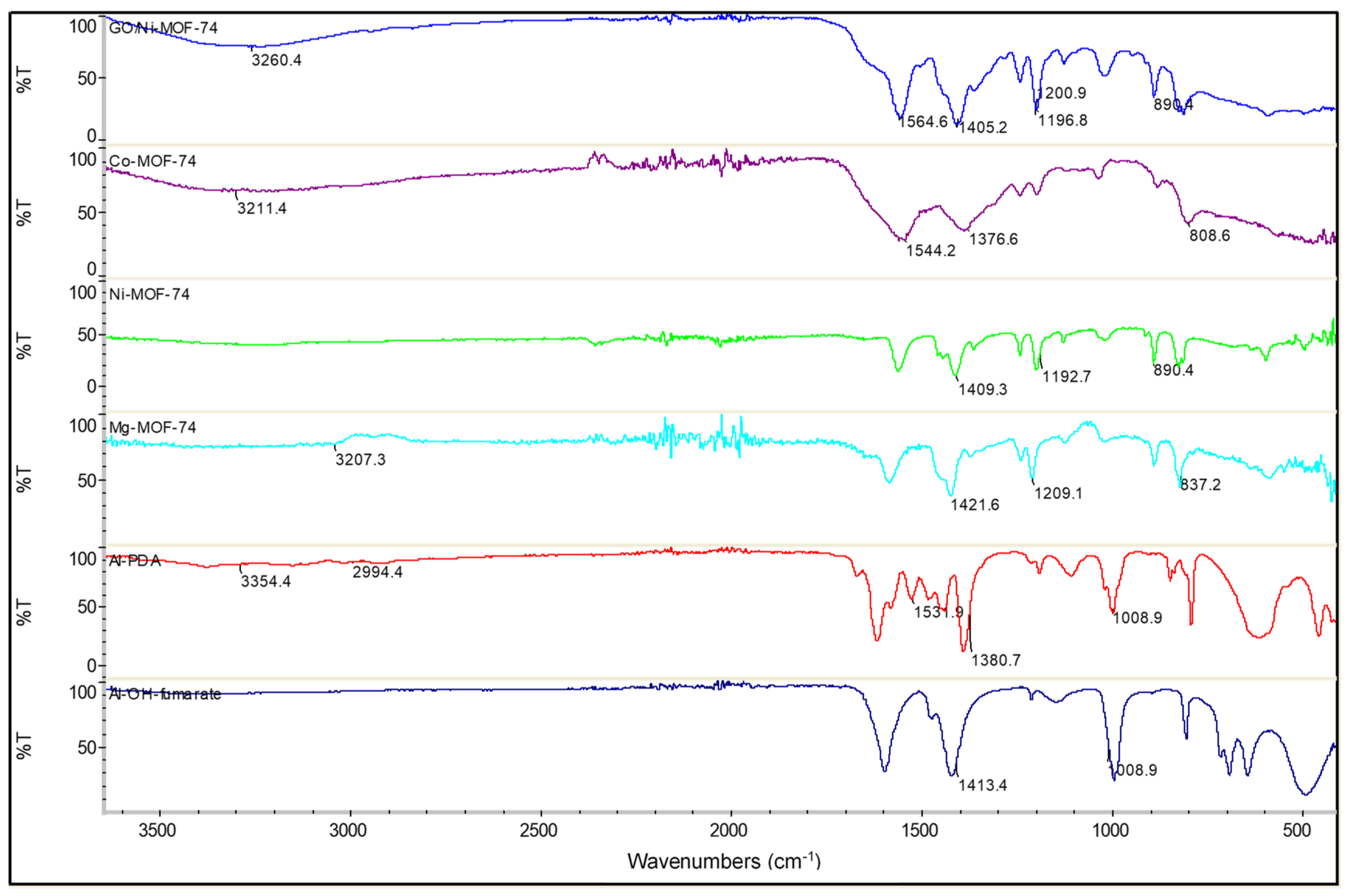

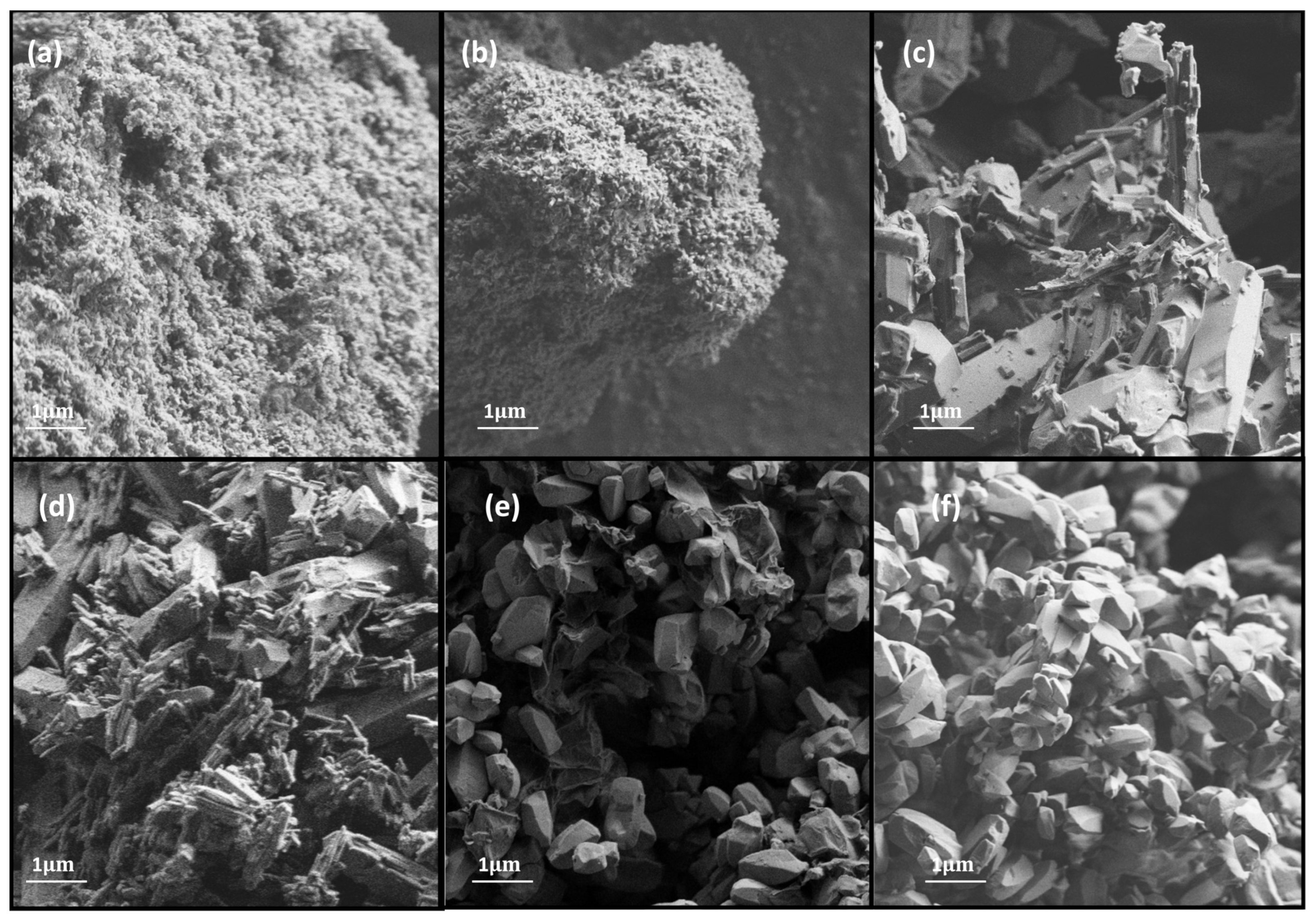

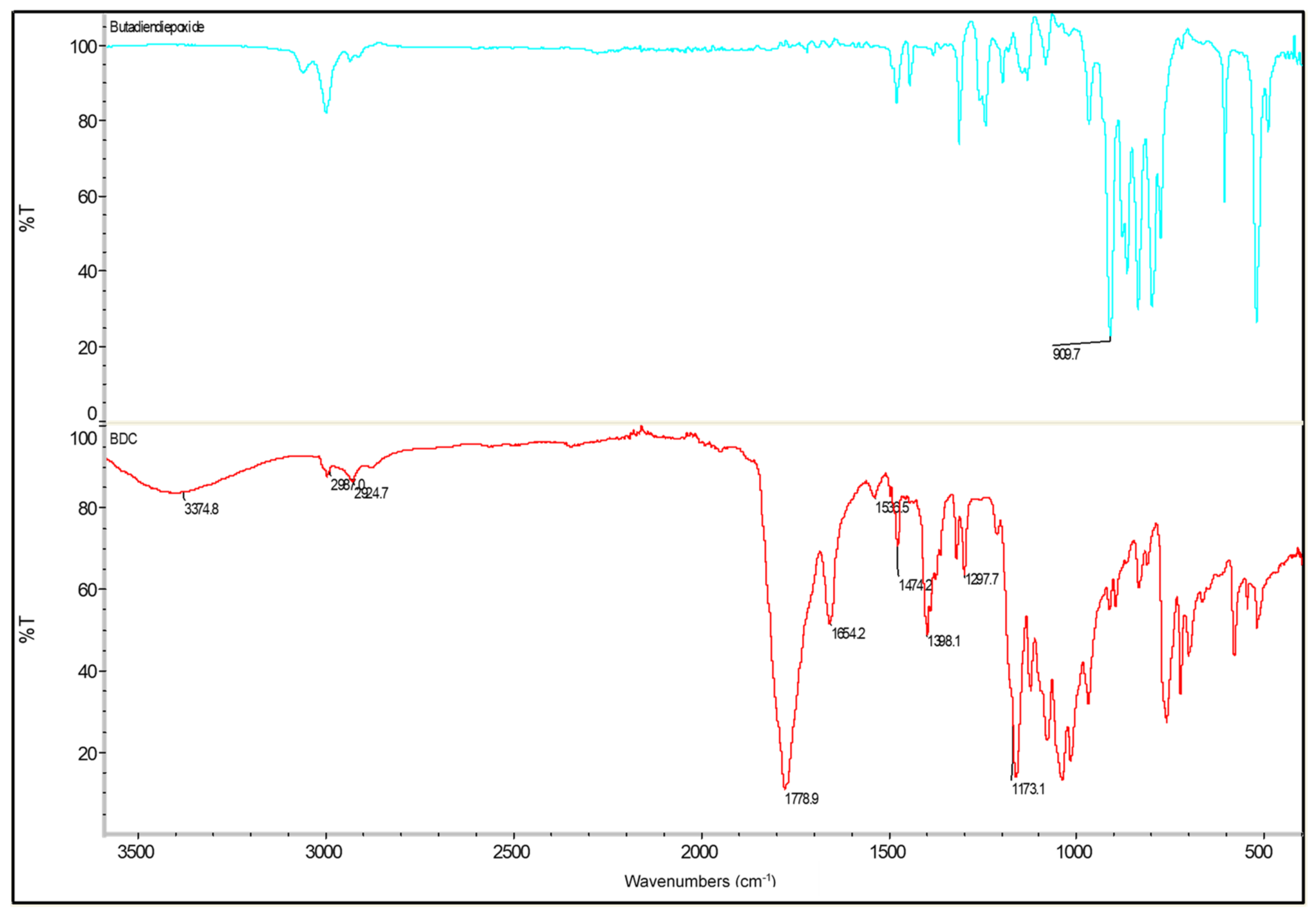
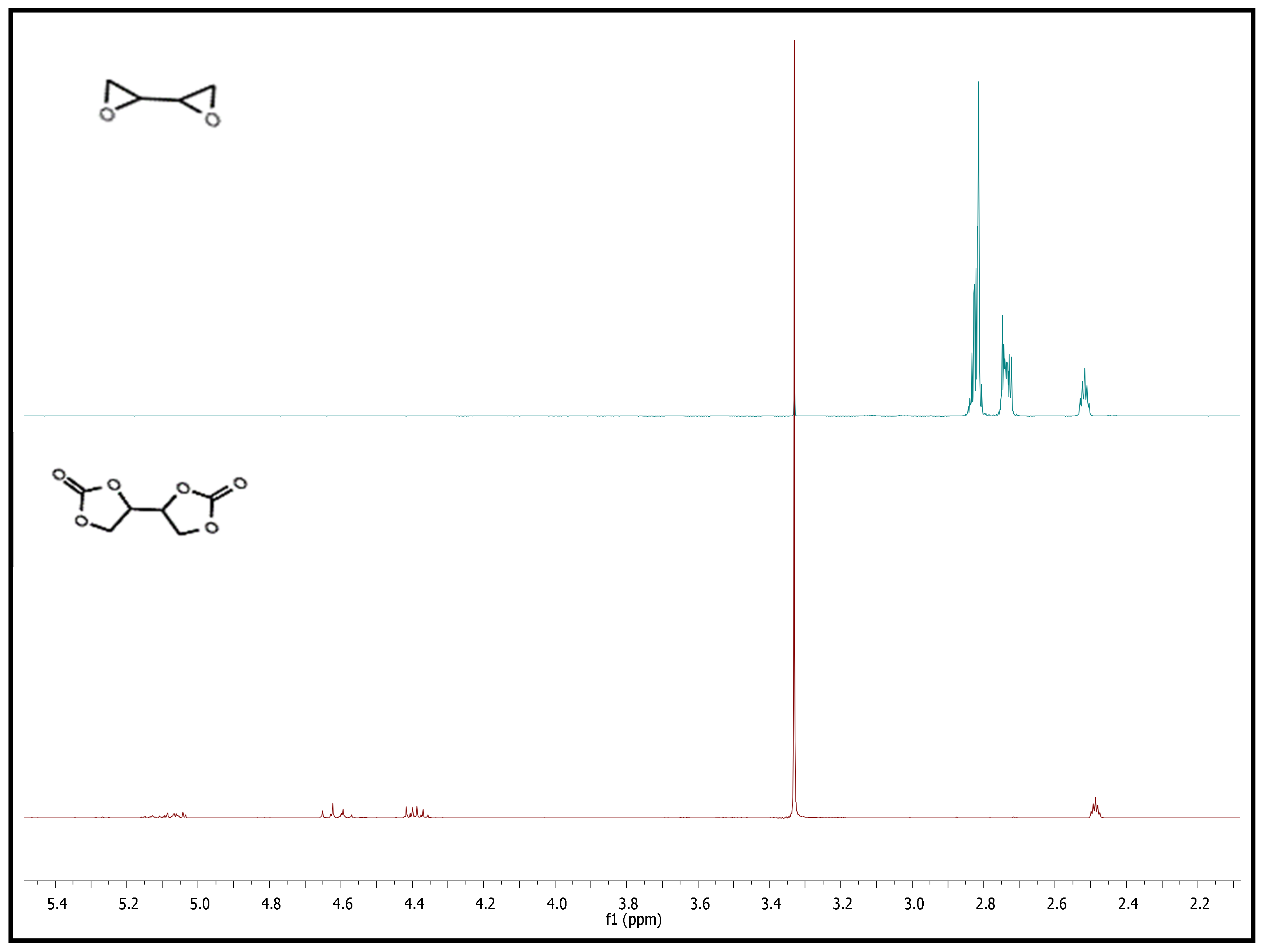

| Catalyst | BET m2/g | Pore Volume cm3/g | Pore Diameter nm | CO2 Adsorbed Quantity * cm3/g |
|---|---|---|---|---|
| Al-PDA | 625 | 0.24 | 4.80 | 53.20 |
| Al-OH-fumarate | 667 | 0.21 | 3.09 | 44.30 |
| Ni-MOF-74 | 527 | 0.23 | 2.33 | 90.20 |
| GO/Ni-MOF-74 | 265 | 0.28 | 4.15 | 8.60 |
| Co-MOF-74 | 31 | 0.03 | 3.16 | 7.30 |
| Mg-MOF-74 | 830 | 0.40 | 2.23 | 7.44 |
| Entry | Catalyst | Catalyst wt % | Co-Catalyst %mol | T h | NMR Conversion a % | GC-MS Conversion % | TON | TOF |
|---|---|---|---|---|---|---|---|---|
| 1 | - | - | 0.01 | 6 | 34 | 27.2 | 352.50 | 58.75 |
| 2 | - | - | 0.01 | 24 | 33 | 26.4 | 327.19 | 13.63 |
| 3 | GO/Ni-MOF-74 | 0.36 | - | 6 | 1.8 | 1.3 | 17.94 | 2.99 |
| 4 | Ni-MOF-74 | 0.36 | - | 6 | 0 | 0 | 0 | 0 |
| 5 | Co-MOF-74 | 0.29 | - | 6 | 2 | 1.4 | 20.08 | 3.35 |
| 6 | Mg-MOF-74 | 0.29 | - | 6 | 0.6 | 0.4 | 5.75 | 0.96 |
| 7 | Al-OH-fumarate | 0.18 | - | 6 | 26.4 | 21.7 | 361.65 | 60.28 |
| 8 | Al-PDA | 0.24 | - | 6 | 11.3 | 6.9 | 106.59 | 4.44 |
| 9 | Co-MOF-74 | 0.29 | 0.01 | 6 | 65.3 | 46.1 | 648.04 | 108.01 |
| 10 | Al-OH-fumarate | 0.18 | 0.01 | 6 | 95.5 | 78.6 | 1304.51 | 217.42 |
| 11 | Al-PDA | 0.24 | 0.01 | 6 | 73.4 | 44.6 | 717.47 | 119.58 |
Publisher’s Note: MDPI stays neutral with regard to jurisdictional claims in published maps and institutional affiliations. |
© 2021 by the authors. Licensee MDPI, Basel, Switzerland. This article is an open access article distributed under the terms and conditions of the Creative Commons Attribution (CC BY) license (https://creativecommons.org/licenses/by/4.0/).
Share and Cite
Benedito, A.; Acarreta, E.; Giménez, E. Highly Efficient MOF Catalyst Systems for CO2 Conversion to Bis-Cyclic Carbonates as Building Blocks for NIPHUs (Non-Isocyanate Polyhydroxyurethanes) Synthesis. Catalysts 2021, 11, 628. https://doi.org/10.3390/catal11050628
Benedito A, Acarreta E, Giménez E. Highly Efficient MOF Catalyst Systems for CO2 Conversion to Bis-Cyclic Carbonates as Building Blocks for NIPHUs (Non-Isocyanate Polyhydroxyurethanes) Synthesis. Catalysts. 2021; 11(5):628. https://doi.org/10.3390/catal11050628
Chicago/Turabian StyleBenedito, Adolfo, Eider Acarreta, and Enrique Giménez. 2021. "Highly Efficient MOF Catalyst Systems for CO2 Conversion to Bis-Cyclic Carbonates as Building Blocks for NIPHUs (Non-Isocyanate Polyhydroxyurethanes) Synthesis" Catalysts 11, no. 5: 628. https://doi.org/10.3390/catal11050628
APA StyleBenedito, A., Acarreta, E., & Giménez, E. (2021). Highly Efficient MOF Catalyst Systems for CO2 Conversion to Bis-Cyclic Carbonates as Building Blocks for NIPHUs (Non-Isocyanate Polyhydroxyurethanes) Synthesis. Catalysts, 11(5), 628. https://doi.org/10.3390/catal11050628





